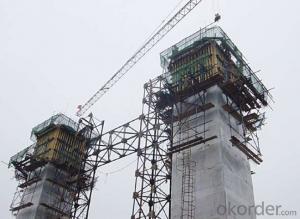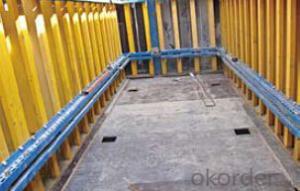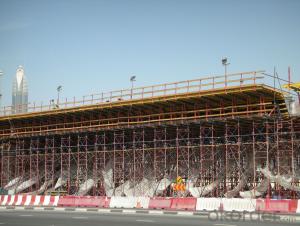Steel-Frame Working Platformfor Formwork and Scaffolding systems
- Loading Port:
- Tianjin
- Payment Terms:
- TT OR LC
- Min Order Qty:
- 50 m²
- Supply Capability:
- 1000 m²/month
OKorder Service Pledge
OKorder Financial Service
You Might Also Like
Steel-frame Formwork SF-140
Characteristics:
◆ Few parts for fast forming.
◆ Max. Concrete pressure: 80KN/m2.
◆ Hot-dip galvanized steel frame.
◆ The thickness of plywood is 18mm & the panel is 14cm.
◆ Compatibility with Hunnebeck Manto system due to similar edge profile.
System Details & Application:
◆ Neat joint and fast assembling with aligning panel clamp.
◆ Flexible panel arrangement and height extension.
◆ The selection of panels.
◆ Kinds of panel connectors.
◆ Corner clamp application.
◆ Length adjustment application.
◆ Height adjustment & aligning strut.
◆ Walkway bracket & platform.


- Q: Can steel formwork be used for both interior and exterior structures?
- Steel formwork is an option for both interior and exterior structures. This material is versatile and durable, capable of enduring diverse weather conditions. It is suitable for both indoor and outdoor environments, providing exceptional strength and stability. Thus, it is ideal for constructing walls, columns, slabs, and beams. Moreover, steel formwork is reusable, which adds to its cost-effectiveness and environmental friendliness. Whether the construction is for interiors or exteriors, steel formwork guarantees a dependable and efficient solution.
- Q: What are the common challenges when using steel formwork?
- There are several common challenges that can arise when using steel formwork in construction projects. Firstly, one challenge is the initial cost of steel formwork. Compared to other types of formwork, such as timber or plywood, steel formwork tends to be more expensive. This can be a barrier for contractors or builders with limited budgets or smaller-scale projects. Another challenge is the weight of steel formwork. Steel is a heavy material, and transporting and handling steel formwork can be physically demanding. This can require additional labor and equipment to safely and efficiently move and position the formwork on-site. Durability is also a concern when using steel formwork. While steel is generally a strong and long-lasting material, it can be susceptible to rust and corrosion if not properly protected. Regular maintenance and protective coatings are necessary to ensure the longevity and performance of steel formwork. Moreover, the versatility of steel formwork can be a challenge. Steel formwork is typically prefabricated and designed for specific applications. This means that if there is a need for customization or alterations during the construction process, it may be difficult to modify the steel formwork to meet the new requirements. This can lead to delays or additional costs. Lastly, the complexity of assembly and disassembly can be a challenge with steel formwork. Steel formwork systems often require skilled labor and specific tools for installation and removal. This can add complexity to the construction process and may require additional time and resources. Overall, while steel formwork offers many advantages such as strength and durability, it also presents challenges related to cost, weight, durability, versatility, and assembly. These challenges should be carefully considered and addressed to ensure the successful use of steel formwork in construction projects.
- Q: How does steel formwork handle different concrete strength requirements?
- Steel formwork proves to be a highly versatile and durable solution, capable of effectively managing a wide range of concrete strength demands. Concrete strength is influenced by its mixture proportions, curing conditions, and the quality of materials employed. By providing a reliable and secure framework for pouring concrete, steel formwork plays a pivotal role in fulfilling these requirements. One notable advantage of steel formwork lies in its ability to withstand the immense pressures and strong vibrations encountered during concrete pouring and compaction. This becomes particularly crucial when dealing with high-strength concrete, as it necessitates greater force application to attain the desired density and durability. Thanks to its structural integrity and rigidity, steel formwork can bear these forces without deformations or failures, consequently ensuring a consistent and uniform distribution of the concrete. Another key benefit of steel formwork is its flexibility in terms of shape and size, allowing for customization to accommodate diverse concrete strength specifications. This versatility facilitates the construction of various structural elements, including columns, beams, walls, and slabs, each with unique strength requirements. Additionally, steel formwork can be effortlessly assembled and disassembled, making it adaptable to different projects and enabling the reuse of formwork components. Moreover, steel formwork imparts a smooth and precise finish to the concrete surface, a crucial factor in achieving desired aesthetics and functionality. This is particularly important for architectural or decorative concrete, where a high-quality finish is imperative. The smooth and flat surface provided by steel formwork ensures even curing of the concrete and minimizes the risk of surface defects. To summarize, steel formwork is well-suited to handle diverse concrete strength requirements due to its robustness, durability, adaptability, and ability to deliver a smooth finish. Its strength and flexibility make it an ideal choice for construction projects demanding varying concrete strengths, guaranteeing the successful execution of diverse structural designs and meeting performance expectations.
- Q: How does steel formwork affect the overall efficiency of the construction process?
- Steel formwork can greatly enhance the overall efficiency of the construction process. This is primarily due to its durability, versatility, and ease of use. Firstly, steel formwork is incredibly strong and can withstand the weight and pressure of concrete without bending or warping. This allows for faster construction as there is no need to wait for the formwork to be repaired or replaced. Additionally, steel formwork can be reused multiple times, reducing the time and cost associated with constantly purchasing new formwork materials. Moreover, steel formwork is highly versatile and can be easily customized to meet the specific requirements of different construction projects. It can be easily adjusted, cut, and welded to create various shapes and sizes, allowing for greater design flexibility. This flexibility also enables faster construction, as the formwork can be quickly modified to accommodate changes in the construction plans. Furthermore, steel formwork is designed to be user-friendly, making it easier and faster for construction workers to assemble and dismantle. It is lightweight compared to other materials like wood or aluminum, reducing the physical effort required during installation and removal. The standardized components of steel formwork also make the assembly process more efficient and less time-consuming. In addition, steel formwork offers improved quality control and accuracy in construction. The smooth surface of steel formwork ensures a consistent finish on the concrete structures, reducing the need for additional finishing work. This not only saves time but also enhances the overall aesthetics of the construction project. Overall, the use of steel formwork significantly improves the efficiency of the construction process by reducing construction time, minimizing material waste, and enhancing the quality and accuracy of the final structures. Its durability, versatility, and ease of use make it an ideal choice for both large-scale and small-scale construction projects.
- Q: How does steel formwork handle different concrete segregation tendencies?
- Steel formwork is highly effective in handling different concrete segregation tendencies due to its strength and durability. It provides a rigid structure that minimizes the risk of concrete segregation during the pouring and curing process. The smooth surface of steel formwork prevents the accumulation of excess water or aggregates, reducing the chances of segregation. Additionally, steel formwork can be easily adjusted and reinforced to accommodate varying concrete placement methods, ensuring uniform distribution and minimizing the potential for segregation.
- Q: What are the common safety guidelines when working with steel formwork in confined spaces?
- When working with steel formwork in confined spaces, some common safety guidelines include ensuring proper ventilation to prevent the buildup of hazardous gases, regularly monitoring the atmosphere for toxic substances, providing adequate lighting and emergency exit routes, wearing appropriate personal protective equipment such as gloves, safety glasses, and respiratory protection, training workers on the potential hazards and safe work practices, and having a standby person outside the confined space to monitor and assist if needed.
- Q: What are the common finishes available for steel formwork?
- Some common finishes available for steel formwork include galvanized, painted, powder coated, and epoxy coated finishes.
- Q: What are the different types of steel formwork systems?
- There are several different types of steel formwork systems commonly used in construction, including traditional steel formwork, modular steel formwork, tunnel formwork, and climbing formwork.
- Q: Can steel formwork be used for both precast and cast-in-place concrete elements?
- Steel formwork is a versatile and durable option that can be used for both precast and cast-in-place concrete elements. It can be reused multiple times, making it suitable for various applications. In the case of precast concrete elements, steel formwork can be shaped and sized according to requirements, ensuring consistent and accurate production in a controlled environment. On the other hand, for cast-in-place concrete elements, steel formwork can be easily assembled and disassembled on-site, providing the necessary support and containment for the fresh concrete until it sets and gains strength. In summary, steel formwork is a flexible solution that can be utilized in multiple concrete construction methods, including both precast and cast-in-place applications.
- Q: Are there any specialized tools or equipment required for steel formwork?
- Yes, there are specialized tools and equipment required for steel formwork. Some of these include steel formwork panels, formwork ties, formwork clamps, formwork brackets, formwork props, and formwork beams. These tools and equipment are specifically designed to handle the heavy loads and provide stability during concrete pouring and curing processes.
Send your message to us
Steel-Frame Working Platformfor Formwork and Scaffolding systems
- Loading Port:
- Tianjin
- Payment Terms:
- TT OR LC
- Min Order Qty:
- 50 m²
- Supply Capability:
- 1000 m²/month
OKorder Service Pledge
OKorder Financial Service
Similar products
Hot products
Hot Searches
Related keywords




















